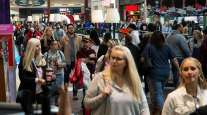Missing-in-Action Consumer Returns as Retail Sales Increase

The American consumer, missing in action for much of 2015, showed up in May.
Retail sales increased 1.2% last month, matching the median forecast of economists surveyed by Bloomberg News and following a 0.2% advance in April, Commerce Department figures showed June 11. The gain was broad-based with 11 of 13 major categories gaining.
The data show American consumers are ready to spend on more than just automobiles, unlocking months of savings from cheap gasoline and higher incomes as the labor market improves. A pickup in purchases — accompanied by faster wage gains — would burnish the outlook for growth this year.
“The consumer took a month off and came back and spent in style,” said Ward McCarthy, chief financial economist at Jefferies in New York, who correctly forecast the increase in retail sales. “Consumers’ behavior has been inconsistent, but the trend has been for gradual acceleration of spending.”
Estimates in the Bloomberg survey of 85 economists ranged from gains of 0.4% to 1.9%. April retail sales previously were reported as little changed. March data were revised up to show an increase of 1.5% from a previously reported 1.1% advance.
Other reports June 11 showed claims for jobless benefits remained below 300,000 for the 14th straight week, and the cost of imported goods rose in May for the first time in almost a year as fuel prices rebounded.
Sales at auto dealers, clothing and building material stores were among the biggest gainers last month, according to the Commerce Department’s report.
Sales climbed 2% at automobile dealers last month after rising 0.7% in April.
Industry data from Ward’s Automotive Group issued earlier this month showed cars and light trucks sold at a 17.7 million annualized rate in May, the strongest pace since July 2005.
Memorial Day promotions drew Americans to dealerships, while an improved job market also had consumers heading to showrooms and paying higher prices by taking out longer loans. General Motors Co. and Fiat Chrysler reported bigger sales increases than analysts had anticipated.
Retail sales excluding autos increased 1%, the Commerce Department report showed. They were projected to rise 0.8%, according to the Bloomberg survey median. It followed a 0.1% gain in April.
The figures used to calculate gross domestic product, which exclude categories such as food services, auto dealers, home-improvement stores and service stations, increased 0.7% in May after rising 0.1% the month before. The reading for March was revised up to show a 0.9% gain compared with a previously reported 0.5% advance, which should boost first-quarter consumer spending when the figures are updated later this month.
Thes figures also shore up growth prospects for the second quarter after unusually harsh winter weather, delays related to a labor dispute at West Coast ports and a stronger dollar caused the economy to contract in the first quarter.
GDP fell at a 0.7% annualized rate from January through March. Household consumption climbed at a 1.8% pace, less than half the 4.4% clocked in the previous three months.
Economists surveyed by Bloomberg last month projected consumer spending to accelerate to a 3.2% pace in the second quarter.
Prior data showed consumers still were hesitant to boost outlays, with purchases stalling in April as Americans used income gains to shore up savings.
“While we’re encouraged by strong Memorial Day sales reports from our customers, inconsistent and sluggish retail conditions on a day-in and day-out basis had caused demand for our products to be relatively flat throughout the first quarter and during the first four weeks of the current quarter,” Paul Toms, CEO at Hooker Furniture Corp., said in a June 4 earnings call. “Longer term, we’ll remain optimistic.”
Weak spending also has affected consumer lenders, such as Bank of America Corp.
“On consumer spending, what we see is a little bit sluggish, particularly in the credit card space as people have deleveraged,” Dean Athanasia, co-head of consumer banking at Bank of America, said at a June 3 industry conference. “They’re not overspending. They saved money from gas, I think.”
The average cost of a gallon of regular gasoline was $2.75 on June 9, compared with $3.64 a year ago. It fell as low as $2.03 in January.
The recent rise in fuel costs propelled a 3.7% jump in receipts at service stations in May, the biggest increase since February 2013, the June 11 Commerce Department figures showed.
Stronger job and wage gains such as those seen in May will be needed to help ensure Americans continue to boost spending in the coming months. Payrolls climbed by 280,000 in May, the biggest gain since December, while hourly pay rose 2.3% from the year before, the most since August 2013.



